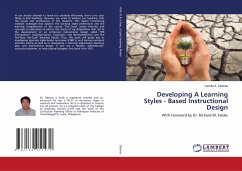
Integration of Instructional Technology in Zimbabwe, Sub-Sahara Africa
Conceptualization, Integration and Constraints
Versandkostenfrei!
Versandfertig in 6-10 Tagen
52,99 €
inkl. MwSt.

PAYBACK Punkte
26 °P sammeln!
Continuous innovations in instructional technologies(ITs) are having an impact on teaching and learningin today s classroom. The merging of Internet-basedtechnologies into the multi- and hyper-mediacapability of the computer has changed the wayeducators and students inquire, communicate andconstruct knowledge. However, there is littlepublished literature on the integration of these ITsin Zimbabwe and Sub-Sahara Africa. This book is partof the genesis of IT research in the region, andexamines the integration of IT in Zimbabwe.Conceptualization of IT is largely as hardware innature and from a na...
Continuous innovations in instructional technologies
(ITs) are having an impact on teaching and learning
in today s classroom. The merging of Internet-based
technologies into the multi- and hyper-media
capability of the computer has changed the way
educators and students inquire, communicate and
construct knowledge. However, there is little
published literature on the integration of these ITs
in Zimbabwe and Sub-Sahara Africa. This book is part
of the genesis of IT research in the region, and
examines the integration of IT in Zimbabwe.
Conceptualization of IT is largely as hardware in
nature and from a narrow systems view, and
integration was at the Entry and Adoption stages.
Constraints ranged from poor availability and access
to technological tools and lack of funding, to the
absence of an IT integration policy framework, and
lack of appropriate initial and continuous staff
development. Insights gleaned should be useful to
policymakers, professionals, practitioners and
scholars interested in IT integration in Zimbabwe and
the region. From a global perspective, this book will
add to the limited knowledge and literature on IT
integration in developing and/or low-income countries.
(ITs) are having an impact on teaching and learning
in today s classroom. The merging of Internet-based
technologies into the multi- and hyper-media
capability of the computer has changed the way
educators and students inquire, communicate and
construct knowledge. However, there is little
published literature on the integration of these ITs
in Zimbabwe and Sub-Sahara Africa. This book is part
of the genesis of IT research in the region, and
examines the integration of IT in Zimbabwe.
Conceptualization of IT is largely as hardware in
nature and from a narrow systems view, and
integration was at the Entry and Adoption stages.
Constraints ranged from poor availability and access
to technological tools and lack of funding, to the
absence of an IT integration policy framework, and
lack of appropriate initial and continuous staff
development. Insights gleaned should be useful to
policymakers, professionals, practitioners and
scholars interested in IT integration in Zimbabwe and
the region. From a global perspective, this book will
add to the limited knowledge and literature on IT
integration in developing and/or low-income countries.












